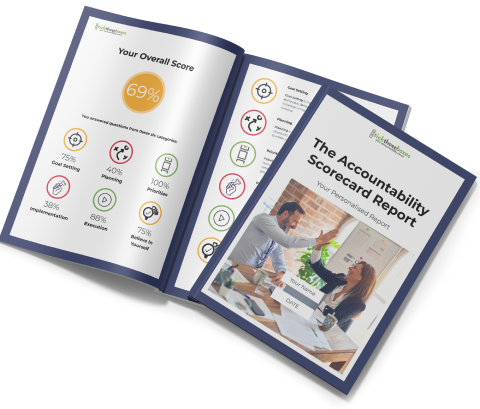
Posted on: 09/08/2023

Accountability is the cornerstone of personal growth, effective teamwork, and organisational success. The “Accountability Ladder” is a powerful model that illustrates various levels of responsibility, from avoidance and blame to proactive problem-solving and leadership. In this blog, we delve into each of the eight classes on the Accountability Ladder and explore strategies to identify and address these levels for personal and professional development.

Discover your Accountability Score and increase the probability of smashing your GOALS and Getting Sh!t Done!
Level 1: Victim Mentality
The Victim Mentality represents the lowest rung on the Accountability Ladder. Individuals at this level view themselves as helpless victims of circumstances, attributing their successes or failures solely to external factors. To address this level, self-awareness is critical. Recognise when you feel powerless and shift your mindset toward taking control of your choices and actions. Practice self-reflection and focus on solutions rather than dwelling on problems.
Level 2: Denial and Avoidance
At this level, individuals deny their responsibility for outcomes and avoid acknowledging their mistakes. To address denial and avoidance, practice introspection and recognise your errors. Embrace vulnerability and admit when you’ve made a misstep. By facing the truth, you can grow and learn from your experiences.
Level 3: Blame Game
The Blame Game involves acknowledging mistakes but quickly shifting responsibility to others. To address this level, foster open communication. Instead of placing blame, focus on the bigger picture and engage in collaborative problem-solving. Taking collective responsibility can lead to a more constructive and accountable work environment.
Level 4: Justification
Individuals at the Justification level provide excuses or rationalisations for their actions. To address this level, practice self-accountability. Instead of explaining away your behaviour, own up to your actions and their consequences. This shift in mindset encourages personal growth and builds trust with colleagues.
Level 5: Shame or Guilt
At this level, individuals acknowledge their mistakes but experience shame or guilt. To address these emotions, practice self-compassion. Understand that making mistakes is a natural part of growth. Focus on learning from your errors and channel that knowledge into positive actions.
Level 6: Obligation
Individuals at the Obligation level fulfil their responsibilities but need more enthusiasm. To address this, connect your tasks to your values and long-term goals. Understand the impact your efforts have on the team and organisation. This shift in perspective can infuse a sense of purpose and commitment into your work.
Level 7: Responsibility
Taking responsibility is a significant step on the Accountability Ladder. Individuals at this level accept ownership of their actions and actively work to rectify mistakes. To further enhance this level, embrace a growth mindset. See challenges as opportunities for growth and continuous improvement. Seek feedback and actively seek solutions when issues arise.
Level 8: Self-Accountable
The Self-Accountable level involves holding yourself to high standards and actively seeking growth. To continue progressing:
Navigating the eight levels of Accountability requires ongoing self-awareness, reflection, and a commitment to personal and professional growth. By identifying where you stand on the Accountability Ladder, you can take actionable steps to ascend to higher levels of responsibility.
To address these levels effectively:
Remember that the journey up the Accountability Ladder is ongoing and non-linear. Each step represents an opportunity for growth and transformation. By consistently addressing the eight levels of Accountability, you can cultivate a culture of responsibility that benefits both yourself and your organisation.
I was excited to join Tia Harmer on The Work in Progress: The Personal Productivity Science Insights Podcast! We dive deep into the science of goal setting and the power of accountability—two cornerstones of business and personal success.